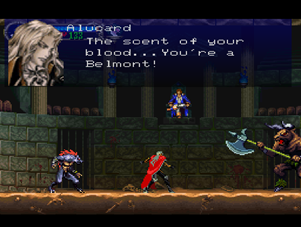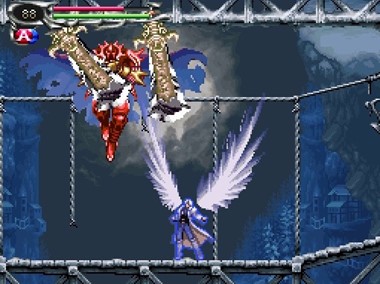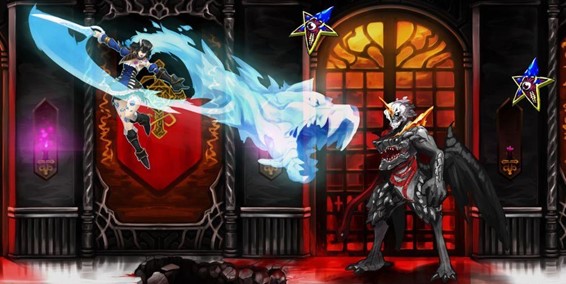 |
Editorial: Why does Castlevania need to be 3d? |
Though I am not versed in the ways of Simon’s Quest, I am someone who believes in the importance of modern history, in the context of games. I believe we have enough modern classics in some franchises to have an informed discussion without having played the ‘golden oldies’, so I will primarily be dealing here with the Castlevania series from 1997’s Symphony of the Night onwards.
So what is the best way to move on within a much-loved franchise? Do we take the parts that we love, and concentrate on developing them and taking them further while keeping everything that works, working? Or can a deeper change be the only real way to move on?
In 2010, Konami seemed to believe the latter. Their thinking was that in order for the series to evolve and stay current, it would have to transition into the third plane.
This is a common assumption by many developers, which in this gamer’s opinion, seems not dissimilar to the assumption that every game nowadays must have an epic storyline with extensive, melodramatic dialogue, likely entailing explosions and the good guys winning in the end.
So, along came Lords of Shadow, the flaws and merits of which could comprise an impressive list each. The most notable of the former however, was that it felt like a patchwork blanket, stitched together from pieces lifted directly from other contemporary games (most notably God of War and Shadow of the Colossus), with some mythical creatures thrown in here or there, to give a smattering of the Castlevania flavour.

We did get some werewolves
The fact is though, that LoS became the best-selling Castlevania game in the history of the franchise.
Is this because it appealed to simpler gaming tastes and blockbuster sensibilities? Frankly, I believe so. In and of themselves, the game’s marketing and AAA aesthetic don’t make it a bad game, especially as there are plenty of great things to say about it. However these flashy elements by no means automatically make a good game either. The mixed reception and sales success of the following two games in the series, which trod a similar path, illustrate this point.
So if 3d plus werewolves do not a good Castlevania game make, then what does? And how does Castlevania make the ‘inevitable’ jump to 3d??
Well, let’s go back to the golden age of Castlevania, which began with Symphony, and continued in the resulting, influential subgenre ‘Metroidvania’, (denoting incremental exploration of an interconnected 2d map in gameplay similar to the games of the Metroid and Castlevania franchises), up to and including 2008’s Order of Ecclesia.

The importance of Symphony lay not just in its quality as a game, but also in how it defined what came after
In particular all of the handheld titles released in this period garnered critical acclaim, with Symphony itself appearing on many a ‘Greatest games of all time’ list, as well as being the best-selling title in the series up until the release LoS.
My proposition is that with this magnificent 2d pedigree, a move into 3d may have been at best, unnecessary, and at worst, misguided for the franchise.
“So should all new Castlevania games just be Symphony clones??” I hear you protest!
Indeed, all of the handheld titles following Symphony did carry the torch of its greatness, but not just that, however—they also continued to explore and improve the formula even further—The greatest example of this being 2005’s excellent Dawn of Sorrow.
But just because something is created in 2 dimensions, does not mean it is limited in how great a game it can be; a game can be expanded or improved by more things than an extra physical dimension. Brave ideas, like Symphony‘s inverted castle revelation, or new elements, like the tactical soul system introduced in 2003’s Aria of Sorrow pay testament to this truth.

The tactical soul system enabled Soma to do funky stuff like this through —duh— stealing the souls of monsters
There is a list as long as my arm of incredible 2d games, just in recent years (games such as Muramasa: The Demon Blade, Ori and the Blind Forest, and even the innovative classic Braid come to mind), the trouble is that gamers and developers alike seem to think of 2d as old, and old as bad.
Even if it could be seen as such however, then recent history actually tells us that this should not be a bad thing, when one looks at the astronomical success (critical and commercial) of the ‘old-school RPG-style’ Souls series; there exists a great majority of gamers who no longer just want something new and flashy purely for the sake of its being so—what they desire is the substance beneath the shiny 3d carapace.
With the LoS trilogy, we can see a game series struggling with its identity while trying to develop. I truly believe the series could have made a successful transition into 3d here, however out of fear of falling flat, it grabbed on to too many things around it at the time; what all the other cool games were doing (combos, quick time events, finishing moves, climbing…), and this polluted its identity to the point where it felt characterless.
Konami had decided to move away from a style of game that had brought them much praise, for the chance at something new and bigger, and there is no shame in this.
Unfortunately however, I feel many game developers, and gamers themselves, fall prey to the trap of the AAA aesthetic, because they begin to think of games too ‘vertically’ (bigger, longer, better graphics). Alas, this can be defeating, as it leaves little energy for thinking laterally (new ideas, systems, ways of playing), and this is where Konami got lost—they put so much effort into thinking about how best to transition to the blockbuster world, that they hadn’t thought enough on whether they should, or on what it really is that makes a great Castlevania game.
Enter legendary producer Koji Igarashi (Affectionately named ‘Iga’ by his fans): A passionate man and one of the minds (many would say the mind), behind Symphony. As a result of his heavy involvement in all of the greatest titles in the series, he has come to be recognised to some extent as the soul of the series, and as someone who acts as the barometer for that certain ‘Castlevania quality’.
Now creating a new game entitled Bloodstained: Ritual of the Night, Iga wanted to demonstrate to potential funders the demand that still existed for 2d Metroidvania-style games, and so he created a Kickstarter campaign for the game. The total funding target was optimistically set at $500,000.
Ultimately the campaign ended up raising a total of $5,545,991—over eleven times its original goal.

The prospect of Iga’s new game prompted gamers to smash the Kickstarter ceiling
Iga had done it, and then some. It is hard to think up something that could more definitively prove to developers the ongoing relevance of 2d games. The money had spoken volumes.
Now, as Konami’s future is uncertain to say the least (they recently announced that mobile games ‘are the future’, and that they will be concentrating most of their energies on that from now on), it does not make me glad that we may not see another 3d Castlevania game on consoles, as I truly believe that there is some way for it to work.
I am glad however, that there was one who was never taken by the pull of perceived vertical progress, and always kept the spirit and gameplay of the series in the driving seat.
Iga’s victory, I feel, has been a humble victory for games.
This guest post was provided by Rory Gibson.